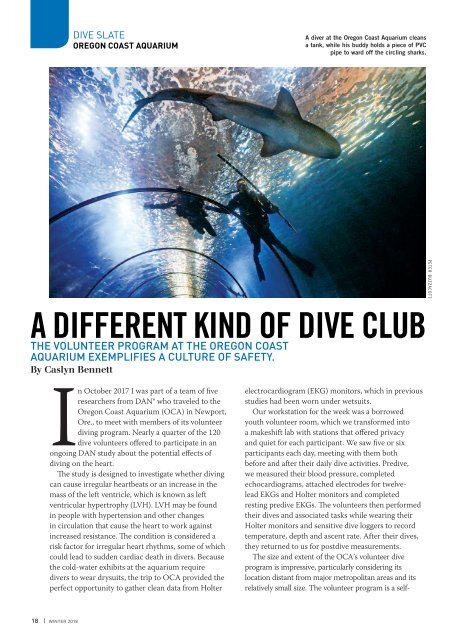AD 2018 Q1
Alert Diver is the dive industry’s leading publication. Featuring DAN’s core content of dive safety, research, education and medical information, each issue is a must-read reference, archived and shared by passionate scuba enthusiasts. In addition, Alert Diver showcases fascinating dive destinations and marine environmental topics through images from the world’s greatest underwater photographers and stories from the most experienced and eloquent dive journalists in the business.
Alert Diver is the dive industry’s leading publication. Featuring DAN’s core content of dive safety, research, education and medical information, each issue is a must-read reference, archived and shared by passionate scuba enthusiasts. In addition, Alert Diver showcases fascinating dive destinations and marine environmental topics through images from the world’s greatest underwater photographers and stories from the most experienced and eloquent dive journalists in the business.
Create successful ePaper yourself
Turn your PDF publications into a flip-book with our unique Google optimized e-Paper software.
DIVE SLATE<br />
OREGON COAST AQUARIUM<br />
A diver at the Oregon Coast Aquarium cleans<br />
a tank, while his buddy holds a piece of PVC<br />
pipe to ward off the circling sharks.<br />
PETER BUZZACOTT<br />
A DIFFERENT KIND OF DIVE CLUB<br />
THE VOLUNTEER PROGRAM AT THE OREGON COAST<br />
AQUARIUM EXEMPLIFIES A CULTURE OF SAFETY.<br />
By Caslyn Bennett<br />
In October 2017 I was part of a team of five<br />
researchers from DAN® who traveled to the<br />
Oregon Coast Aquarium (OCA) in Newport,<br />
Ore., to meet with members of its volunteer<br />
diving program. Nearly a quarter of the 120<br />
dive volunteers offered to participate in an<br />
ongoing DAN study about the potential effects of<br />
diving on the heart.<br />
The study is designed to investigate whether diving<br />
can cause irregular heartbeats or an increase in the<br />
mass of the left ventricle, which is known as left<br />
ventricular hypertrophy (LVH). LVH may be found<br />
in people with hypertension and other changes<br />
in circulation that cause the heart to work against<br />
increased resistance. The condition is considered a<br />
risk factor for irregular heart rhythms, some of which<br />
could lead to sudden cardiac death in divers. Because<br />
the cold-water exhibits at the aquarium require<br />
divers to wear drysuits, the trip to OCA provided the<br />
perfect opportunity to gather clean data from Holter<br />
electrocardiogram (EKG) monitors, which in previous<br />
studies had been worn under wetsuits.<br />
Our workstation for the week was a borrowed<br />
youth volunteer room, which we transformed into<br />
a makeshift lab with stations that offered privacy<br />
and quiet for each participant. We saw five or six<br />
participants each day, meeting with them both<br />
before and after their daily dive activities. Predive,<br />
we measured their blood pressure, completed<br />
echocardiograms, attached electrodes for twelvelead<br />
EKGs and Holter monitors and completed<br />
resting predive EKGs. The volunteers then performed<br />
their dives and associated tasks while wearing their<br />
Holter monitors and sensitive dive loggers to record<br />
temperature, depth and ascent rate. After their dives,<br />
they returned to us for postdive measurements.<br />
The size and extent of the OCA’s volunteer dive<br />
program is impressive, particularly considering its<br />
location distant from major metropolitan areas and its<br />
relatively small size. The volunteer program is a self-<br />
18 | WINTER <strong>2018</strong>









